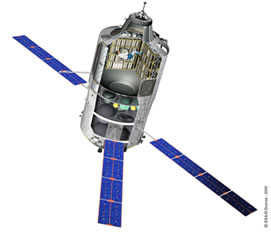They are participating in the construction and entry into service of the second Automated Transfer Vehicle (ATV), which carries almost eight tons of supplies to the International Space Station (ISS).
The astronauts who live in the International Space Station need to periodically receive supplies of all types: fuel, food, water, oxygen, etc. Automated space mission supply ships take care of this provisioning function. One of these ships, the second in the ATV series called Johannes Kepler, was just sent into space on a mission that will last three and a half months. The vehicle weighs more than 20 tons and has been developed, built and operated by the European Space Agency. On this mission, during which it is transporting almost eight tons of supplies, ten Spanish companies have participated: Deimos Space, Alter Technology Group Spain, EADS Astrium Crisa, EADS CASA Espacio, GMV, GTD, Iberespacio, Indra Espacio, Rymsa and Thales Alenia Space España.
Each one has a different task. Alter has been in charge of the supply, testing and engineering for electrical components used by all of the companies involved in the design and construction of the ATV.
Deimos has participated in the development of the simulation platform and validation of the cargo ship’s software.
EADS Astrium Crisa has manufactured the communications equipment that guarantees the approach maneuvers of the vehicle with the International Space Station. EADS CASA Espacio assembled the structures of the supply ship and the separation system, which holds the ATV to the launch vehicle. Once the desired orbit is reached, explosive bolts are fired to separate the two halves that form the so-called ring, thus liberating the ATV.
GMV has created the flight dynamics system and carried out GPS navigation studies, while GTD has participated in the flight software and automatic docking software.
Iberespacio has done risk testing from the point of view of the security of the space station. Indra Espacio has designed and installed the tracking station for the mission, from the island Santa María de Azores. Rymsa has been in charge of the design and construction of some communication antennas. And finally Thales Alenia Space España made the communications equipment for the vehicle’s docking maneuvers with the space station.
Agencias/El País
